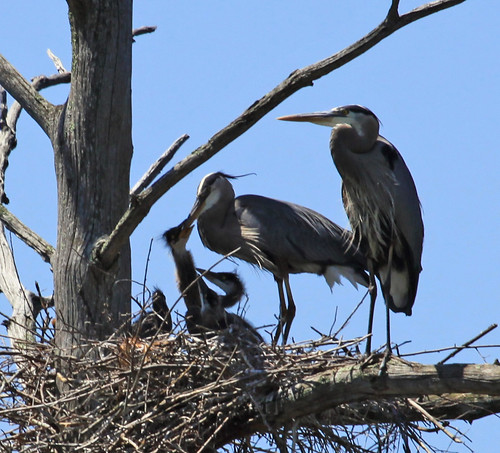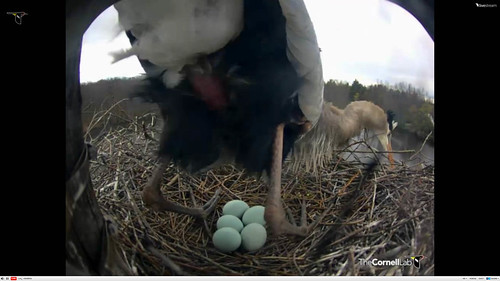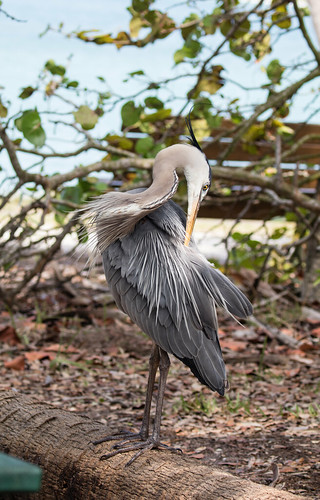In 2009, when I was armed with my very first good camera and was working full time at the Cornell Lab of Ornithology, I took daily walks through Sapsucker Woods, photographing whatever I could. One particular Great Blue Heron was exceedingly calm around people, giving me lots of opportunities to take his photo, so I took hundreds. I loved parking myself on a bench or tree stump and just watching him, with his calm, Zen-like manner and patience. In every photo that showed his feet, I could see that he was missing his right hind toe and the claw from his left middle toe.
That same spring, someone sent out an email to tell us all that he’d just seen a pair of Great Blue Herons carrying sticks up to a big dead white oak tree in the middle of the pond right outside the Lab. We watched the male carrying up a LOT of sticks, one by one, delivering them to the female who simply could not wedge the sticks into the tree to stay—the oak was so old and had been worn so smooth that there were no little crevices to make it easier to wedge a stick in place. No one kept count, but the male brought in dozens of sticks, each falling into the pond. One time in apparent frustration he tried to show the female how it was done, but the issue wasn’t her skill, it was the tree itself. She gave him sort of an “I told you so” look—she'd have rolled her eyes if Great Blue Herons could do that—and off he went to find yet another stick. Finally, a stick stuck. Only a few more sticks dropped before a second stayed in place, and then they were in business.
I was fascinated, and spent the entire season photographing the pair and their four nestlings, all of which successfully fledged. Then in 2012 when I was back at home, the Lab installed a nest cam and I could watch the birds up close and personal. I have no idea whether the female was the same bird as in 2009, but I know the male was the same, because of that missing toe and claw.
He nested another few years before the nest came crashing into the pond along with the main weight-bearing branch, fortunately before any eggs were laid that year. Months later, he got into a fight with another Great Blue Heron, seemed injured, and never returned the next spring. I believe the final tally of young he successfully fledged on that pond during the time he was under our observation was at least 21. We have no idea whether he nested somewhere else before 2009, and also don’t know if he nested somewhere else after the nest blew down in 2015.
I’ve always liked Great Blue Herons well enough, but never grew fascinated with the species until I got to know this one individual—to see up close and personal how patient he was with his nestlings, and how he always dropped his fishy meals closest to the tiniest nestling to give the little guy a fighting chance; to see how he stayed on the eggs during a snow storm, not budging from sunset one night until late afternoon the next day, when he finally flew off, apparently to give a piece of his mind to the female, and then returned to the nest until she finally appeared. To know any kind of bird really well, learning how it negotiates life on this beautiful but fraught planet, is to love that bird. Last week I heard from Steve Dahlberg, who hears me on KAXE. What he wrote captures beautifully what makes this bird uniquely special:
Like many other listeners, it’s hard for me to pick a single favorite bird and there are lots of stereotypical ones I could pick. The one I chose is the Great Blue Heron. There’s something about its majestic stillness when it hunts and its calm solo flights that has a profound effect on me whenever I see one. I think they are the monks of the bird world, living always in the quiet eternity of the present moment.
“The quiet eternity of the present moment.” That is so perfect, so apt for this particular bird, and something to aspire to in our own lives, at least occasionally. As I watch for my first Great Blue Herons of spring to fly in on deep, steady, patient wingbeats, knowing they’ll get here soon enough, I’ll practice being patient myself.





